It’s a satisfying gurgle, the sound forged through dark water as a foam creation tied dreamily late one winter night is retrieved in fits and starts over dark, north woods water six months later. Yellow with red painted-on dots, trailed by two white marabou feathers and a few strands of tinsel, it passes as a popper, albeit a poor man’s creation.
It’s exactly as I pictured it, floating high and proud above the murky surface of Reindeer Lake on the longest day of the year. It weaves and darts and kicks up that satisfying “popper bubble” on its way back to the boat. Then a swirl. A big one.
“You see that?” I ask the guide, George, a native Cree from the Paul Ballantyne First Nation.
“Yuh,” he says through a mouth missing many of its teeth. George is like a lot of the native guides in the north country. They help guide anglers all summer, and subsist on what they can derive from the boreal woods the rest of the year—moose and fish, proceeds from trapping and the like. He’s been on this water for 40 years, and was quick to note that, already this year, an angler had boated a 48-inch pike under his tutelage.
I tug the line again and the popper disappears into an ivory white maw lined with teeth and roof-of-the-mouth barbs that ensure that anything that gets caught in those jaws never escapes. The water erupts, the 40-pound Maxima Chameleon leader goes tight and fly line rips through the guides of the 7-weight.
Fish on, baby. And all I can do is giggle.
That’s pike fishing. It’s not about the fight, which is perfectly respectable. It’s not about the tail-walking leaps or the backing-stretching runs—those are both rare. It’s about the take. The hit. The eat.
The attack.
It happens so fast. So unsuspectingly fast. You think you can anticipate it, expect it. But you can’t. These fish glide through shallow water, masters of camouflage. If you see them, they likely see you, too. But, I honestly believe, they don’t give a damn. They’ll slyly follow a fly for 30 feet, and only when you’re contemplating a recast do they move in and take a desperate swipe. If pike truly hate anything, it’s letting a potential meal get away. They can’t help themselves. They evolved to eat.
Just a few minutes later, as George fights to get the 30-inch creature’s gator-like mouth open to remove the fly, I take a look around. I’m somewhere on the border with Saskatchewan and Manitoba, floating on a legendary lake filled with fish just like this one. Only bigger. Much bigger.
Skinny black spruces and green, lush birches line every channel, every bay and every rocky bluff. Willows and marsh grasses creep into the water, and, even this early in the season a few lily pads start to spring up, offering more cover, more places to hide and more places from which toothy pike can ambush unsuspecting baitfish, leeches, grayling, whitefish … even smaller pike.
“This would be a good lunch fish,” George says, as he almost regrettably drops the fish back into the water and watches it dash away into the deep.
“Keep fishing,” he says. “There’s more.”
Rough landing
We had just arrived that morning on a charter flight from Winnipeg. We stopped for gas in the little outpost of Flin Flon, Manitoba, a mining town named after a fictional character who discovered the route to the center of the earth and found it made of gold. The town is circled by lakes and sloughs and home to the Flin Flon Trout Festival—a month-long fishing party where lake trout take center stage. About 45 minutes after refueling, we touched down roughly on an island airstrip in the middle of Reindeer Lake and swerved to a sketchy stop on the gravel runway. The charter flight captain, in attempting to turn around and prepare for the flight out, dug the front landing gear into the runway, leaving the plane stuck in the sand at the end of the airstrip.

With the help of the 10 passengers heading home from Arctic Lodges, the crew was able to push the plane back out of the sand and presumably get it ready for the flight south.
The lodge staff piled our gear into a couple of skiffs, and the passengers there for the week hopped aboard other boats. Fifteen minutes later, we were at the lodge, which sits at the southern tip of a small island and on a sweet little channel, just across from yet another island. Reindeer Lake is a massive body of water, scarred with islands—thousands of them. Some are massive, and boast rocky bluffs that overlook deep water. Others are small—just a few hundred yards across—and host shallow bays with skinny-water entrances from the deep water. No island is identical, and the spot the Littlechild family picked for their lodge decades ago — dotted with rustic, yet eminently comfortable cabins, each complete with a wood stove — has that comfy summer camp feel about it. It’s homey and welcoming.
On the water
I think we took the Lodge’s claim, “You’ll be fishing by 10 o’clock” with a grain of salt. But damned if we weren’t. We arrived at the dock just a bit after breakfast and George looked us up and down skeptically.
“Those the only rods you brought?” he asked in his Cree Canadian accent, giving our fly rods a skeptical glance.
“Yep,” I said. “This is it.”
“No trolling rods?”
“We don’t want to troll, “ I said. “We want to catch pike on flies.”
George frowned. Clearly he had something else in mind when he got up that morning.
Fly fishing for pike is growing in popularity, but it’s still a rarity on the lakes up north. Lodge owner Kelly Littlechilds says most people who come up throw tried-and-true spoons and spinners with names like the Dardevle and the Krocodile, or they go deep for lake trout with hardcore terminal gear. But, he says, it seems more and more folks are bringing fly rods along, presumably to chase grayling (which are also common in the lake), but then see the long rod’s merit when it comes to targeting pike.

Chasing pike with a fly rod is a much more intimate experience than it is with traditional spinning gear—on blue-bird days, it’s often a sight-fishing endeavor that requires casts no longer than 30 feet. Sometimes, pike, being the voracious eaters they are, will follow a fly to within feet of the boat before deciding if your offering is edible. And the offerings are, more often than not, big hunks of fur and feather that don’t necessarily need to meet any particular pattern—or rhyme or reason for that matter—but only need to succeed in accomplishing one simple feat: piquing the curiosity of these massive fish and getting them to attack.
And attack they do. Pike are often besmirched for being questionable fighters, and I suspect that’s because the traditional pike angler is equipped (over-equipped?) with heavy line, wire leaders, rods more at home on salty blue water and often lures or plugs boasting two sets of treble hooks. From my experience, it also seems that the guides who pilot anglers out on the lakes of the North Country expect a quick fight once a fish is on the line. When you’re boating a pike with a rod more appropriate for offshore fishing, the fight would be, predictably, short. But, hook a 40-inch behemoth on a 7-weight fly rod, and I suspect most of those long-held beliefs would be altered.
No, they don’t go on long, backing-stretching runs, and they rarely leap from the water (though they sometimes do). Instead, they shake their heads madly, dive deep and wind themselves around weeds, root wads and boat motors—with a mouth that is not accustomed to spitting things out, it’s uncanny how many fish can do just that if you don’t keep a tight line.
So when that first pike inhaled the popper, the three of us on the boat giggled with delight. And when George finally got the fish’s mouth open to remove the fly, he was pretty pleased, too.
“Much easier to remove just one hook,” he said.
Lunch fish
Our last day on Reindeer Lake was downright stunning. High cumulus clouds erupted into afternoon thunderstorms visible from miles away. Our guide for the day, Otto Olson, who, like George, is a Cree native, steered us around squalls and heavy water, depositing us in shallow bays loaded with toothy pike all morning.

We’d all hooked respectable fish in the 35- to the 38-inch range that morning (and we’d all boated at least one 40-inch fish over the four-day trip), and we kept Otto humming at the net and at the unenviable task of removing flies from critters that that boast teeth seemingly everywhere, from the edge of the jaws to the gill plates. As lunchtime approached, Otto steered his boat toward that of our fishing buddies and asked their guide, Daniel, the all-important question.
“How many fish you got?”
Daniel held up one finger.
Otto turned to study the two Americans in his boat. I stand 6 feet, 5 inches tall and have some Sasquatchean characteristics, and Kirk sports a healthy elk-hunting belly.
“That’s not enough,” Otto said, shaking his nervously. “We need to catch at least one more.”
Catch fish, or no lunch? That’s motivation, no?
We both started casting madly into the tea-colored water of the little bay. During our last pike trip together, Kirk and I bet dinner on the last day on who would catch the largest pike. Three casts later, I boated a 40-inch behemoth, and that night, enjoyed a steak on him in Saskatoon.
“Put a pork chop on the table, and you’re pretty focused,” he said.
Truth be told, I’d rather have a fresh shore lunch than a steak or a pork chop any day—it’s the best meal on the planet, as far as I’m concerned. Flash fried filets of pike that were swimming that morning, perfectly prepared fried potatoes and a heaping portion of beans … it may not be a heart-healthy choice, but it’s damn tasty, even if it does lead to a cacophony of farts and snorts at the lodge later that night.
So there was some skin in the game when Otto announced we didn’t have enough fish for shore lunch.

I’d noticed that, in some of the murkier bays where we’d spent the week fishing, some of the pike would come to hand with little black leeches attached to their scales. This was one such murky bay, and I’d been having good luck with a long, black, rabbit-strip streamer pulled through the water with random retrieves. I cast the water-logged fly down below the boat, gave it one pull, and the line stretched tight. Really tight. Then, the reel, with the drag set heavy, began to sing.
“Lunch fish?” Otto asked.
“I think this thing could feed an army,” I said. “It’s too big for lunch.”
It felt heavy, like I’d hooked a water soaked beanbag with fins and teeth. But, even with both boats within 30 feet of each other, nobody could get a good look at it. Every time I’d gain a little ground, the kraken at the end of my leader would simply shake its head and, in a very un-pike-like manner, go on a long run, ripping line from the reel and exposing the backing on my spool.
Otto looked at me each time the fish went on a tear and grinned.
“He’s big, huh?”
“He’s big,” I said, wondering, since I was occupied with easily the biggest pike of my life, who the hell was going to catch the rest of our lunch.
Then the beast turned and started swimming right at us. The reel wasn’t fast enough, and I had to retrieve line as fast as my arms and hands would work. It charged under the boat and I stabbed my 7-weight rod into the water to keep the line tight and slowly work the creature from the deep back into a manageable position.
Then it happened. Everybody got a look. The beast waved it’s boat-oar sized tail and erupted from the water, where it seemed to glide along the surface, displacing the lake and leaving behind a wake of whitewater as it charged west toward Alberta.
It sounded like a fireworks show, with the “Oooohs” and “Ahhhs” coming from me, my buddies and both the guides. Daniel laughed out loud, and Otto slapped his thighs.
“I need to get me a fly rod,” he said. Otto later told us that he was serious about this claim. In his mind, the approach to chasing pike on flies is actually more effective than going after them with traditional gear. With a more quiet approach and the ability to change flies, the speed of the retrieve and the heft of the rod, he believes fly fishers might be best equipped to chase pike. It made sense later that day as we all tucked into a little bay known locally as the Slaughter Hole—for about three hours, four of us probably caught 50 fish a piece without moving more than 100 yards from where we started. It was like bluegill fishing, but for massive, unruly fish with unsavory attitudes.
The leap and the porpoise was the last gasp of the massive fish I’d hooked just before we broke for lunch. Moments later, it came to the net, and Otto measured it at 45-and-a-half inches. It was a beast, with a head fit for Rushmore.

If you go
Where to stay
Arctic Lodges, run by Kelly and Andrea Littlechild, is a great host, and the price is right at $3,395 for five days and four nights. If you’re scoring at home, that’s about half the price of an Alaskan trout and salmon trip and proof that pike are a bargain. The Littlechild family has owned the lodge for decades, and they know how to treat guests.
That said, northern Saskatchewan is rich with fishing lodges—there are literally dozens of them dotting the north country, and they all offer the chance to get into massive pike, grayling and lake trout. Do your research, and pick a lodge that meets your needs, as you’ll find you have plenty of options.
What to bring
Leave the waders at home for Arctic Lodges, and if you decide on another locale, be sure to check with the lodge before you bother to pack waders. There are grayling in Reindeer Lake, but you can cast to them from the boat (some other lodges offer great river fishing for grayling, and your waders will be helpful). Kelly is going to explore some of the rivers and streams in his area for potential walk-and-wade grayling fishing in the coming months, but for now, pike (and, if you arrive early enough in June or late enough in August, lake trout in the shallows) are what it’s all about. Most gear guys fish in blue jeans and comfortable clothes, with rain gear just in case. We wore flip-flops and sandals on the boats, and donned rain jacket to ward off the inevitable squalls. As for gear, a 7- to 9-weight rod is adequate, with corresponding reels and floating fly lines. For leader, I use Maxima Chameleon fishing line, 40-pound test. It blends with the color of the water, it’s supple, turns over heavy flies without a problem, and it’s tough. A lot of guys use wire leader—I had one fish bite through the leader, and if I caught one, I caught 100. Those are good odds. For flies, go with red-and-white, yellow-and-white and black. Add lots of flash, barbell eyes and go long—even consider articulated streamers. Nothing is too big for these fish to eat.
How to get there
Fly into Winnipeg. Rates from all over the U.S. are reasonable, and the cost of the charter flight from Winnipeg to Reindeer Lake is included in your Arctic Lodges rate. Other lodges might have you fly into Saskatoon or Regina, but all of them generally include the price of the charter from civilization to lake country farther north.

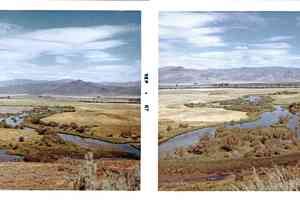
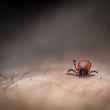


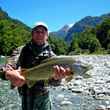
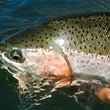
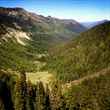
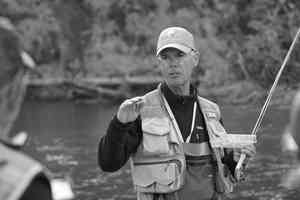
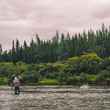

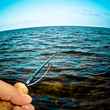
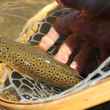

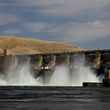

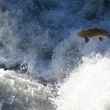

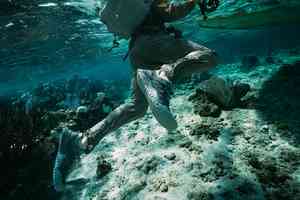
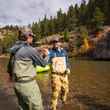
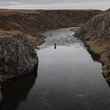
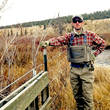

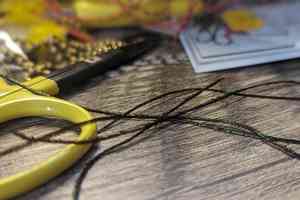
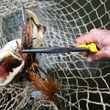
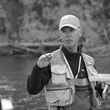


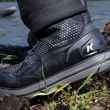



Comments
Jill Cameron replied on Permalink
Amazing article! I felt like I was right there watching the entire adventure! Chris....you're amazing and extraordinarily talented.
Pages